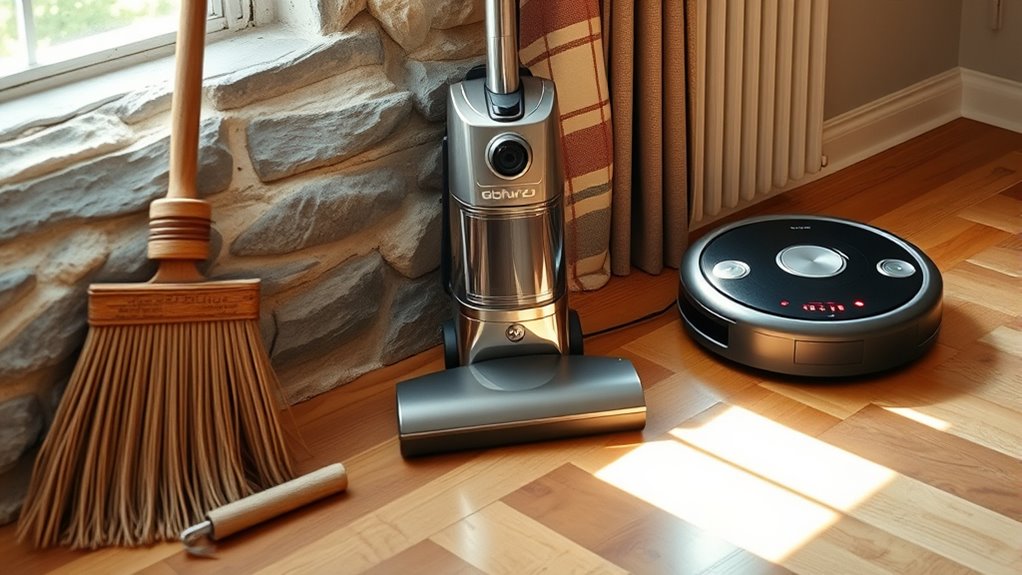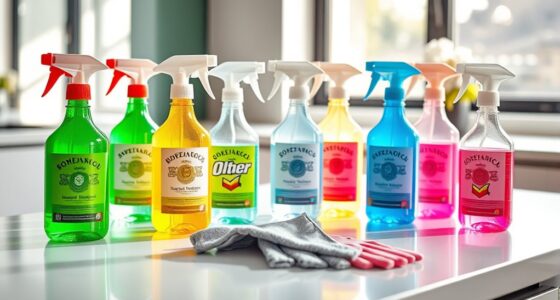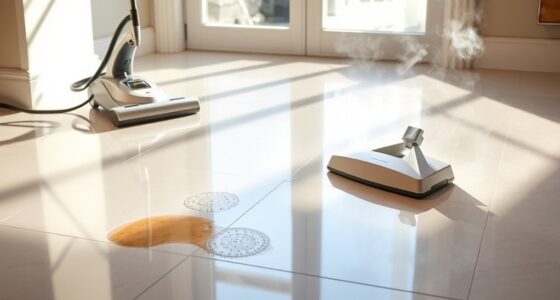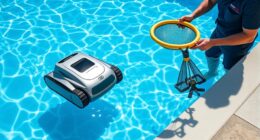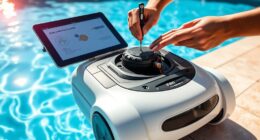The history of cleaning tools spans from simple brooms to advanced robotic vacuums, showcasing humanity’s quest for efficiency. In the 19th century, innovations like the carpet sweeper emerged, leading to motorized models. The 20th century introduced portable vacuums and disposable bags for convenience. By the late 20th century, bagless designs and robotic cleaners entered the scene, offering smart navigation and enhanced filtration. There’s much more to uncover about this fascinating evolution and the technology that drives it today.
Key Takeaways
- Cleaning tools evolved from simple brooms and carpet sweepers in the 19th century to sophisticated motorized vacuums by the early 20th century.
- The introduction of bagged vacuum cleaners in the 1920s improved hygiene and convenience for consumers.
- James Dyson’s 1978 bagless vacuum revolutionized cleaning efficiency with cyclonic separation technology.
- Robotics entered the cleaning arena with the 1996 Electrolux Trilobite, the first robotic vacuum cleaner.
- Modern vacuums utilize AI, sensors, and smartphone connectivity for autonomous cleaning, enhancing user experience and air quality.
Early Innovations in Vacuum Cleaning
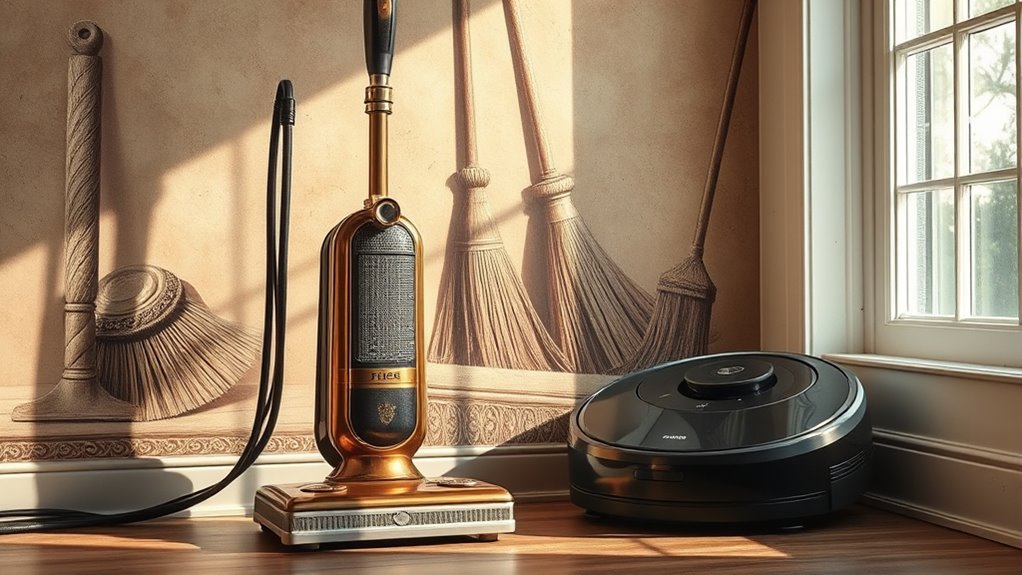
As cleaning needs evolved, innovators stepped up to create tools that transformed how we tackle dirt and dust.
The journey began in 1860 with Daniel Hess’s carpet sweeper, which used air streams to draw dust—a precursor to the vacuum cleaner. Color accuracy is also crucial in ensuring that cleaning equipment performs effectively. Incorporating natural materials into cleaning tools can enhance their effectiveness and promote sustainability. Additionally, the development of best vacuums for hardwood floors has contributed significantly to the efficiency of modern cleaning methods.
Then, in 1901, Hubert Cecil Booth introduced “puffing Billy,” the first motorized vacuum cleaner, but it required external operation through tubes.
In 1901, Hubert Cecil Booth revolutionized cleaning with “puffing Billy,” the first motorized vacuum cleaner, though it relied on external tubing.
Fast forward to 1907, James Murray Spangler created a portable motorized vacuum cleaner with a rotating brush and dust bag, paving the way for designs commercialized by William Henry Hoover.
The 1920s brought disposable paper bags, enhancing convenience and hygiene. Furthermore, advancements in suction power have significantly improved vacuum performance over the years.
Development of Motorized Vacuum Cleaners
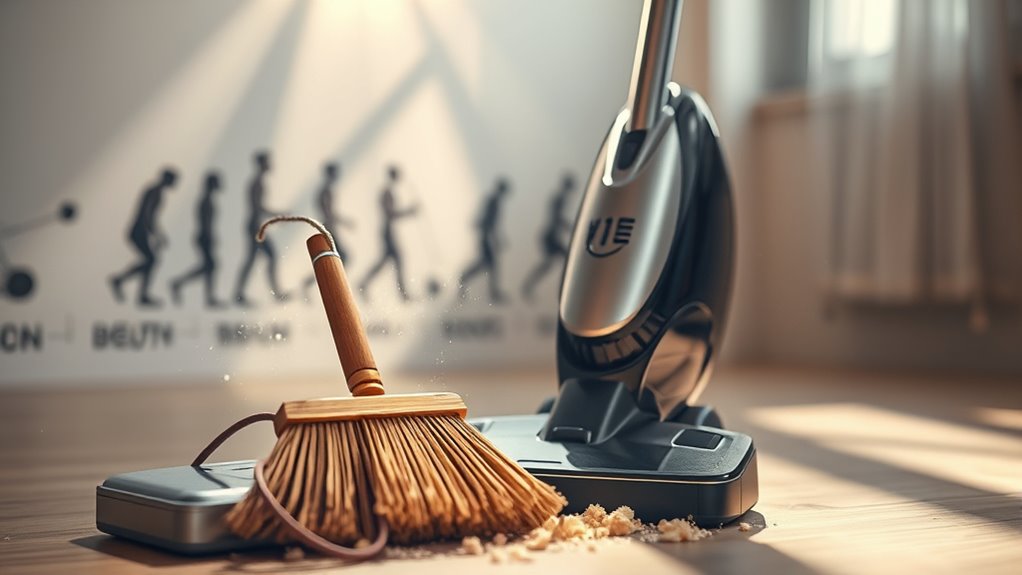
The development of motorized vacuum cleaners revolutionized home cleaning, making it more efficient and accessible.
In 1901, Hubert Cecil Booth introduced the first motorized vacuum cleaner, using an internal combustion engine to clean from outside buildings. Just a few years later, Walter Griffiths created a compact version in 1905, designed for one-person use, which made vacuum cleaners more user-friendly. Regular filter replacement is crucial for maintaining optimal performance in modern cleaning devices. Additionally, advanced cleaning technology has continued to evolve, offering features that enhance efficiency and ease of use. Furthermore, the introduction of professional cleaning services has made specialized cleaning tasks more manageable for homeowners.
By 1907, James Murray Spangler invented the first portable model with a rotating brush and dust bag, paving the way for William Henry Hoover’s commercial success.
The 1920s brought disposable paper bags, changing how dirt was collected.
Finally, in 1978, James Dyson’s bagless technology improved suction efficiency, marking a significant leap forward in vacuum cleaners. This innovation parallels modern toilet functionality advancements that enhance cleaning and efficiency in bathrooms.
Advancements in Vacuum Technology

Vacuum technology has seen remarkable advancements that continue to reshape how we approach cleaning.
In the 1920s, disposable paper bags improved convenience and hygiene, while the 1930s brought lightweight plastic models, making vacuums accessible to more consumers. These innovations laid the groundwork for modern top rated vacuums, which are designed to perform efficiently on various surfaces, much like the airless paint sprayers that offer smooth finishes in painting tasks. Energy-efficient options in vacuum designs have also contributed to their growing popularity.
Fast forward to 1978, and James Dyson introduced the first bagless vacuum, utilizing cyclonic separation after developing over 5,000 prototypes.
The 1996 launch of Electrolux’s Trilobite marked the first robotic vacuum, paving the way for future innovations despite early navigation challenges.
Today, devices like the Dyson V15 Detect incorporate mapping technologies and laser sensors for enhanced dirt detection and automatic suction adjustments, ensuring you get the most efficient clean possible. These advancements truly transform your cleaning experience, with smart features that allow for greater control and convenience in maintaining cleanliness.
Bagless and Robotic Innovations
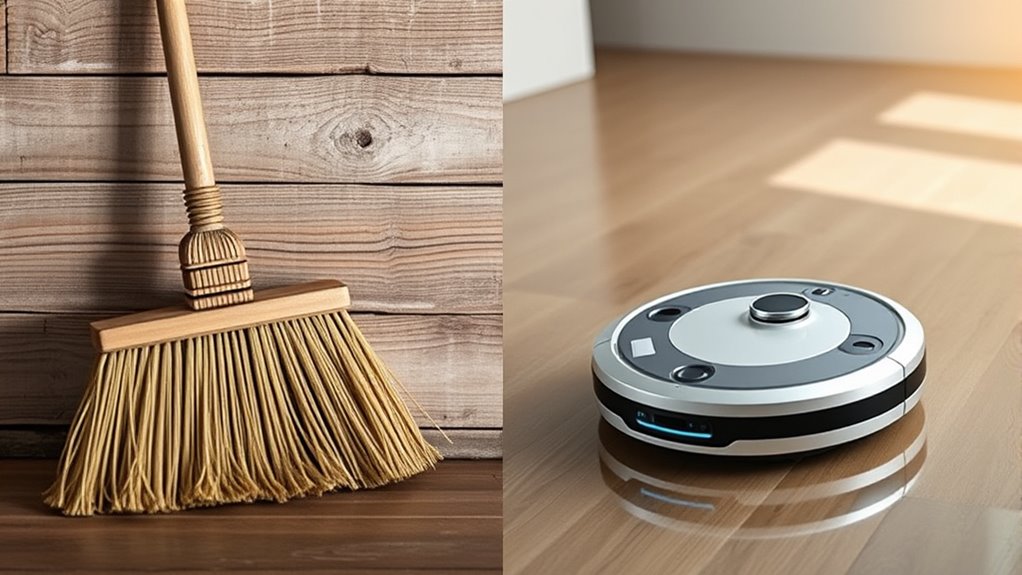
Innovations in vacuum technology have taken a significant leap forward with the introduction of bagless and robotic models.
In 1978, James Dyson changed the game by creating the first bagless vacuum cleaner, eliminating the hassle of disposable bags and enhancing efficient cleaning through cyclonic separation. This innovation parallels the development of airtight coolers, which also aim to improve efficiency by minimizing air exchange. Proper filtration is essential for maintaining indoor air quality, especially for allergy sufferers, and contributes to reducing allergens in the home environment.
James Dyson revolutionized cleaning in 1978 with the first bagless vacuum, simplifying the process and maximizing efficiency through cyclonic technology.
Just a year later, Black & Decker introduced the Dust Buster, a cordless handheld vacuum that made quick clean-ups a breeze.
The 1996 Electrolux Trilobite paved the way for robotic cleaning, despite its navigation hurdles.
Fast forward to 2021, and you’ve got the Dyson V15 Detect, featuring laser technology that reveals hidden dust for even more efficient cleaning. These innovations have transformed how you tackle dirt and debris in your home. Additionally, modern vacuums often incorporate advanced filtration systems to enhance indoor air quality and cater to allergy sufferers.
Modern Autonomous Vacuum Cleaners

As technology advances, modern autonomous vacuum cleaners have revolutionized how you maintain cleanliness in your home. Devices like the Electrolux Trilobite and iRobot Roomba use sophisticated sensors and AI to navigate efficiently, adapting to your cleaning patterns.
Here’s what makes them essential:
- Remote Control: You can schedule cleanings and monitor progress through a smartphone app, giving you more freedom.
- Advanced Filtration: With HEPA filters, these vacuums trap fine dust and allergens, improving your air quality.
- Versatile Features: Many models come with self-cleaning brushes and dual vacuuming/mopping capabilities, making cleanup effortless.
- Energy Efficiency: These cleaners are designed to optimize power usage, which can significantly reduce long-term operational costs, allowing you to save money while keeping your home clean.
These innovations make your cleaning routine smarter and more efficient, allowing you to focus on what truly matters.
Frequently Asked Questions
What Is the History of the Vacuum Cleaner?
The vacuum cleaner’s history starts in the 1860s with the first mechanical broom, which pushed dirt into a container.
By 1901, Hubert Cecil Booth introduced the motorized vacuum, but it could only work from outside buildings.
In 1907, James Murray Spangler created a portable version, paving the way for commercial success.
The 1920s brought disposable bags for better hygiene, and in 1996, robotic vacuums emerged, revolutionizing cleaning with automation.
Will Cleaners Be Replaced by Robots?
You might wonder if cleaners will be replaced by robots, and the answer isn’t straightforward.
While cleaning robots are gaining popularity and becoming more efficient, they won’t completely replace human cleaners just yet.
Many tasks still require a personal touch or specialized skills that robots can’t replicate.
Instead, you could see a collaboration where robots handle routine chores, freeing up cleaners to focus on more complex tasks and providing better service overall.
What Did People Do Before Vacuum Cleaners?
Before vacuum cleaners, cleaning was a real chore—like trying to catch smoke with your bare hands.
You relied on brooms, dusters, and beaters to tackle dirt and dust. It took hours, and your arms often felt like jelly! You’d sweep and beat carpets, hoping to dislodge any grime.
Those manual methods left you exhausted, but they were the best options until more efficient innovations came along.
Cleaning was simply a matter of hard work and persistence.
How Did Vacuum Cleaner Impact Society?
Vacuum cleaners have greatly impacted society by transforming how you approach cleanliness. They’ve saved you time and effort, making regular cleaning less intimidating.
With the convenience of portable models, you can tackle dirt in various spaces, promoting healthier living environments. Additionally, advancements like HEPA filters enhance air quality, raising awareness about environmental health.
Conclusion
As you reflect on the journey of cleaning from humble brooms to sophisticated robots, remember that “necessity is the mother of invention.” You’ve witnessed how each innovation has made our lives easier and transformed our homes. Today’s autonomous vacuums free you from tedious chores, allowing you more time for what truly matters. Embrace these advancements, knowing they’re not just tools, but a symbol of our enduring desire for a cleaner, more efficient life.

